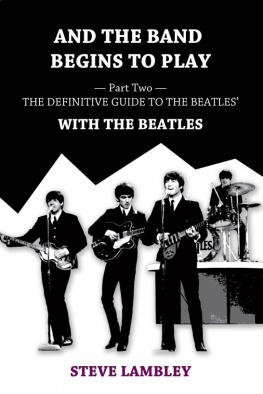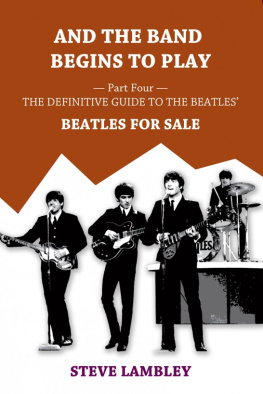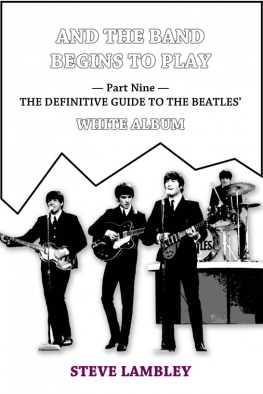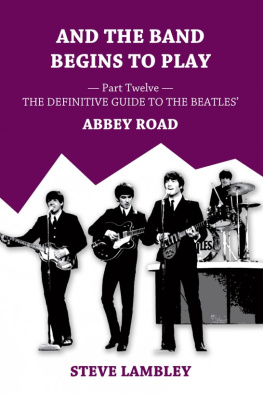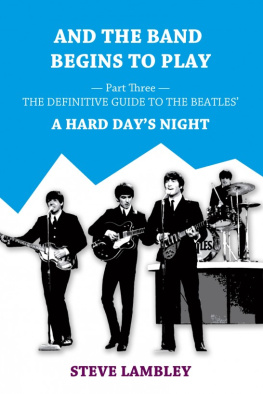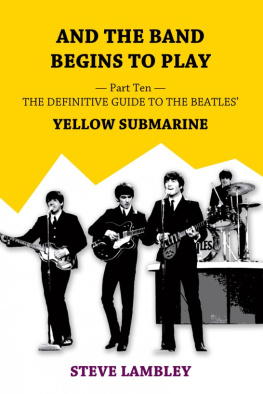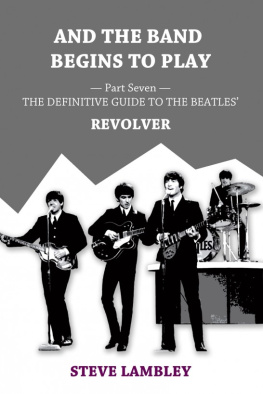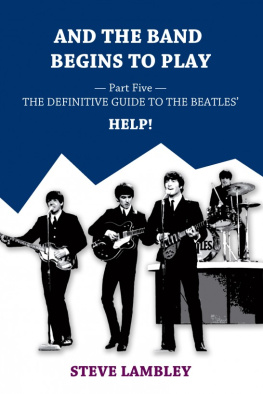AND THE BANDBEGINS TO PLAY
Part Nine The Definitive Guide to the Beatles WHITE ALBUM
by
SteveLambley
Published bySLIDE Books
Version 2.0
Steve Lambley2015
All song lyricsremain the copyright of their respective owners, and are quoted forthe purposes of scholarship, under fair dealing and fair usagelaws. No infringement is intended.
No part of thisbook may be reproduced in any form without written permission fromthe copyright holder.
SmashwordsEdition, Licence Notes
This ebook islicensed for your personal enjoyment only. This ebook may not bere-sold or given away to other people. If you would like to sharethis book with another person, please purchase an additional copyfor each recipient. If youre reading this book and did notpurchase it, or it was not purchased for your use only, then pleasereturn to Smashwords.com and purchase your own copy. Thank you forrespecting the hard work of this author.
Table of Contents
Single release
Parlophone R 5675 Released 15 March 1968
Lady Madonna
[Lennon-McCartney]
Recorded 3, 6 February
Mixed 15 February (mono), 2 December 1969 (stereo)
Paul leadvocals, piano, bass, possibly tambourine
John harmony and backing vocals, lead guitar
George harmony and backing vocals, lead guitar
Ringo drums
Session musicians two baritone saxophones, two tenorsaxophones
With LadyMadonna, the Beatles revisited ground they had not covered sincemid-1966. The release of an out-and-out R&B style single showeda desire to return to their roots, although Ringo commented at thetime, Its not a backwards step, its just another type of songfrom the Beatles. In fact, the record was a temporary, butunderstandable skip away from both the psychedelia of Pepperand the relative simplicity of the previous two singles, with theblues influence evident for the first time since Revolver.Hunter Davies went so far as to describe the song as mock-rock, asatirical look back at the Beatles music of 1963.
Thisexamination of popular musics recent past was reinforced by therelease in early 1968 of songs such as Don Partridges skifflethrow-back Rosie, and by the subsequent re-release of BillHaleys Rock Around The Clock and Buddy Hollys Peggy Sue/RaveOn, both of which charted in April 1968. That summer, the RollingStones released their back-to-roots Jumping Jack Flash, electingnot to stray far from the style for the rest of their career. Whilethe Beach Boys August number one single reflected Well, Ive beenthinking bout all the places weve surfed and danced and all thefaces weve missed, so lets get back together and Do ItAgain.
As for LadyMadonna, the tenor of the distinctive introduction was apparentlypartly inspired by the Rolling Stones hit from the previous year,Lets Spend The Night Together, but more so by a 1956 hit fromthe Humphrey Lyttelton Band called Bad Penny Blues (which wasalso released on Parlophone, although not produced by GeorgeMartin). Paul had also seen Fats Domino in concert in New Orleans,which also helped in the early stages to form the tone of the song.(Fats Domino immediately recognised Pauls tribute and recorded hisown version of Lady Madonna, which was released on his 1968 albumFats Is Back.) The Beatles were continuing to move towards apiano-based sound, with the guitar licks of I Feel Fine and DayTripper giving way to Hey Bulldog and Hey Jude. While PaulsLady Madonna riff does not have the beautiful simplicity and rawpower of, for example, the symmetrical introduction to HeyBulldog, it is stark, instant and captivating.

LadyMadonna was me sitting down at the piano trying to write a bluesyboogie-woogie thing. I got my left hand doing an arpeggio thingwith the chord, an ascending boogie-woogie left hand, then adescending right hand. I always liked that, the juxtaposition of aline going down meeting a line going up. That was basically what itwas. It reminded me of Fats Domino for some reason, so I startedsinging a Fats Domino impression. It took my voice to a very oddplace.
The song alsohas a second, simpler, but equally chromatic riff a walkingbluesy Hey Bulldog-style motif in counterpoint, in which both theguitars and saxophones rejoice.

The richsequence of flattened thirds, sixths and sevenths, also picked onby the bass in its march up and down the scales, combined with themarvellously syncopated rhythm, produce a single of great characterand charm. This sequence, a repeated AD (IIV) until the finalFGA (bVIbVIII), underpins the whole song. The middle eightmoves into the key of C, flirting with DmG (iiV), beforeresolving beautifully with the fabulous CBm7E7sus4E7(Ivii7III7sus4III7; in A: bIIIii7V7sus4V7), this fleetingappearance of the dominant, E, making us realise we have beenmissing it all along.
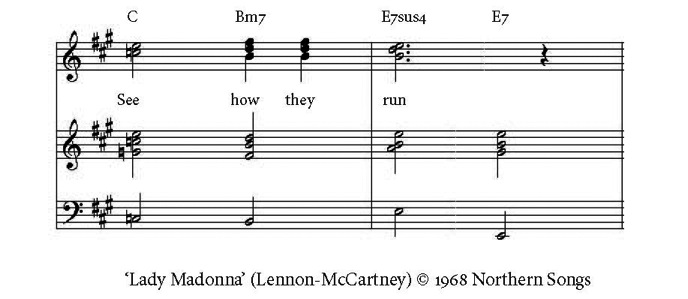
The semitoneslide from C to Bm before the resolution involving two fifthdescents, to E7 and to A, with the internal E7 sus4E7 move itselfincluding a semitone slide from A to G#, is quite simplymasterful.
Also notablein the bridge is the relentless descent of the bass line steppingdown a fearless twelve notes from D through to G, with just asingle registral break after the first bar.

The songsstructure and direction, although in many ways following on fromHello, Goodbye, give it its own unique character. The ascendingriff, reinforced by the bass, gives an optimistic glow to theverse. This is reversed when realism is injected, setting off anunremitting downward climb from bass and piano, as the days arereeled off, cataloguing week after week of getting by and makingdo. Pauls days-of-the-week lyric looks back to the Wednesdaymorning of Shes Leaving Home, and forward to the Sundays onthe phone to Monday of She Came In Through The Bathroom Window(which again uses the Dm chord to pivot from A to C for thebridge). The songs form a neat trilogy of the diaries of threeentirely different women.
John toldPlayboy that he felt he may have had a hand at helping Paulto write the song, but in any case did not rate the lyric veryhighly. However, on the evidence of the lyrics structure andcontent, we can guess that Johns help on this song was minimal.Paul, adept at constructing scenarios with a strong cast andmemorable plot, conjures up the life of a woman, or womankind as hesees it, in a series of dazzling images and similes. Her string ofchildren, all ages and all types, have one thing in common theneed of their mother.
Theinspiration for the title of the song is said to come from aphotograph in National Geographic of a Malaysian woman,captioned Mountain Madonna: with one child at her breast andanother laughing into her face, sees her quality of lifethreatened. But Pauls view of women, as Barry Miles points out inPauls official Beatlesong biography, Many Years From Now,stems from his post-war northern working-class roots. Thematriarchal society that typified the north-west of England inparticular at that time bred strong, dedicated, no-nonsense wivesand mothers with an uncomplicated attitude to life and sex and thewhole damn thing.
Next page
![Lambley And the Band Begins to Play: [Part9 The Definitive Guide to the Beatles White Album]](/uploads/posts/book/213743/thumbs/lambley-and-the-band-begins-to-play-part9-the.jpg)
![Lambley - And the Band Begins to Play: [Part1 The Definitive Guide to the Beatles Please Please Me]](/uploads/posts/book/213741/thumbs/lambley-and-the-band-begins-to-play-part1-the.jpg)

![Lambley - And the Band Begins to Play: [Part6 The Definitive Guide to the Beatles Rubber Soul]](/uploads/posts/book/213742/thumbs/lambley-and-the-band-begins-to-play-part6-the.jpg)
